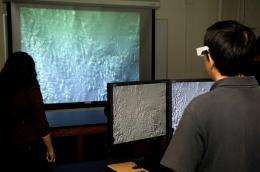A 3-D world: New technology allows students to take virtual field trips

(PhysOrg.com) -- The geosciences center may be ordering 3-D glasses by the hundreds, but students won’t be watching Avatar.
They will be using the new “geowall” that allows them to travel across the world, under the sea, and down through mountains, earthquakes, volcanoes, and other natural phenomena on earth and in space, all without leaving Storrs.
The geowall is not a wall at all but a six-by-eight-foot screen that superimposes images using two LCD projectors in addition to a two-by-two array of LCD screens with 20-million pixel resolution. The projection system also has cameras, microscopes, scanners, and sophisticated 3-D processing software.
“The system allows us to do things in a virtual way that we would have had to spend hours and hours doing in a tedious, traditional way,” says Pieter Visscher, head of the Center for Integrative Geosciences and a professor of marine sciences in the College of Liberal Arts and Sciences. “The system provides an incredible state-of-the-art tool to educate geoscience students in the basic sciences, and to provide faculty an opportunity to further their research.”
The $125,000 wall was funded by the Fund for Innovation established by Harold and Paula Schwenk to create projects that create a synergy between teaching and research.
Without the wall, faculty teaching students about earthquakes, volcanic eruptions, tsunamis, and other phenomena used movies, plastic 3-D maps, or aerial photographs.
“These traditional methods of demonstrating phenomena to students fail to communicate the interconnectedness and four-dimensionality of earth and environmental processes,” Visscher says.
The system allows users to, among other things, zoom in, connect rock formations under and above the sea, measure the dimensions and weight of a rock, map a fossil, visualize mineral structures, or obtain biogeochemical information about sediments, all with the use of a mouse and key pad. So researchers no longer have to chip off part of a rock in order to analyze it, for instance.
The center will have virtual field trips to remote places, such as the Australian outback and Taiwanese gorges, and plans to use images of extraterrestrial exploration.
The geowall is useful for map interpretation, microscopy, and 3-D images, and can demonstrate the fundamentals of a range of objects, from molecular structures to seismic wavefronts.
It also allows researchers to look at high-resolution photos of fossils and life organisms and other objects, and to study sediment, volcanoes, tsunamis and other waves, landscapes, and images from satellite photos, such as the federal geographic information system.
The projection system also allows instructors to project a microscopic image, for instance, of a mineral and rotate it in three dimensions.
The geowall will be used by more than 800 students in basic science classes. More than 200 other students a year will also benefit from the technology, Visscher says.
Because of its broad applications, the geowall will be used by faculty and students in a number of CLAS departments including anthropology, chemistry, ecology and evolutionary biology, geography, marine sciences, molecular and cell biology, and several departments in the College of Agriculture and Natural Resources and the School of Engineering.
The system is complemented by a camera that is now on loan to UConn by NASA. The camera eventually will be used on the Mars Science Lab, the next generation of Martian Rover.
“This system is critical for students so they can understand our planet, its history, and its future,” Visscher says. “They can use the system to look at the effects of global warming, and they can ‘travel’ around the world in a way that would be cost-prohibitive for large groups of students.”
The system will also help prepare students for jobs, since it is similar to that used by some industries, such as oil and gas.
Provided by University of Connecticut
















